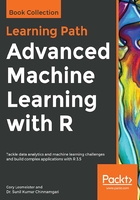
Loading the data
As for this data, it is the same that we used in Chapter 2, Linear Regression. What is different is that I've prepared the data exactly as before, but saved the features and response as an RData file. You can download that from GitHub: https://github.com/PacktPublishing/Advanced-Machine-Learning-with-R/blob/master/Data/amesDL.RData.
Once you have that in your working directory, load it into the environment:
> load("amesDL.RData")
Notice that you now have four new objects:
- trained: The training data features
- tested: The testing data features
- train_logy: The log of home sales
- test_logy: The log of home sales
It is essential that the data is centered and scaled for a neural network (in the prior exercise, all features were either zero or one, which is acceptable). To perform this task, a function is available in the caret package. Let's use the training data to create the mean and standard deviation values that we will apply to both train and test data:
> prep <- caret::preProcess(trained, method = c("center", "scale"))
> trainT <- predict(prep, trained)
This gives us our transformed training data. However, Keras will not accept a dataframe as an input. It needs an array for both the features and the response. This is an easy fix with the data.matrix() function:
> train_logy <- data.matrix(train_logy)
> trainT <- data.matrix(trainT)
Now, you can just repeat these steps with the test data features:
> testT <- predict(prep, tested)
> testT <- data.matrix(testT)
It's about to get interesting.